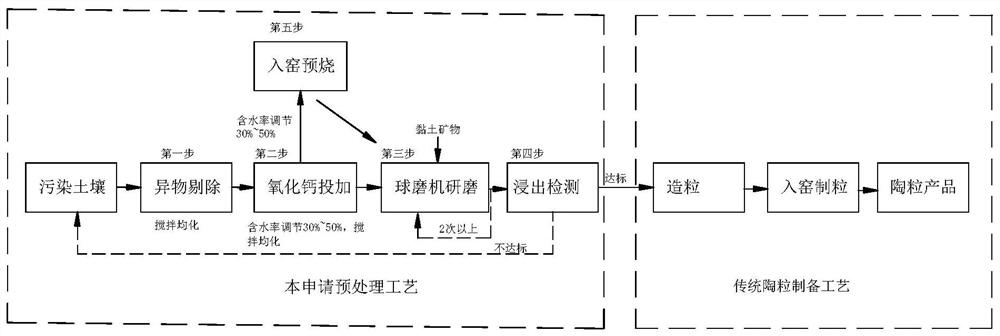Pre-treatment method for preparing ceramsites from heavy metal contaminated soil before entering kiln
A technology for polluted soil and heavy metals, applied in the field of polluted soil reuse, can solve the problems of blindness and process feasibility analysis in heavy metal polluted soil, and achieve the effects of low heavy metal release, low chemical dosage and strong solidification ability.
- Summary
- Abstract
- Description
- Claims
- Application Information
AI Technical Summary
Problems solved by technology
Method used
Image
Examples
Embodiment 1
[0047] Take the decommissioned soil of an electroplating factory, the heavy metal copper content is 8321mg / kg, and the zinc content is 4390mg / kg. After being treated according to the general ceramsite preparation process, the release concentration of heavy metals from ceramsite is lower than that of the original soil, but copper and zinc can still be detected in the leachate (see Table 1).
[0048] This soil reference figure 1 The process shown, after the three-step pretreatment of "removal of foreign matter→addition of 1% calcium oxide→adding water (water content 45%)→mixing kaolin with ball mill for 3 times", the "Solid Waste Leaching Toxic Leaching Method Sulfuric Acid Nitric Acid Method" ( HJT299-2007) test results show that the leaching concentration of copper and zinc exceeds the relevant limit of Class III surface water.
[0049] Subsequently, ceramsite was prepared according to direct granulation, and the original soil was re-according to "removing foreign matter → ad...
Embodiment 2
[0056] Take the soil of a decommissioned plot of a metal pipe drawing factory, and its heavy metal nickel content is 1400mg / kg. According to the traditional ceramsite preparation process and the matching pretreatment process ("removing foreign matter → adding 1% calcium oxide → adding water (moisture content 50%) → roasting ceramsite kiln once (gradually heating up from 400°C to 1150°C, the whole time 45min) → mixed kaolin ball mill grinding 3 times (to the silicon dioxide content in the soil reaches 65%) → granulation to prepare ceramsite) The ceramsite preparation process respectively processes the heavy metal polluted soil, in this embodiment, granulation prepares ceramsite The process is specifically the same as in Example 1. The results are shown in Table 2.
[0057] Table 2 Concentration of heavy metals released under acid rain leaching of materials before and after the process (mg / L)
[0058] test group Nickel concentration original soil 2.07 No ...
PUM
 Login to View More
Login to View More Abstract
Description
Claims
Application Information
 Login to View More
Login to View More - R&D
- Intellectual Property
- Life Sciences
- Materials
- Tech Scout
- Unparalleled Data Quality
- Higher Quality Content
- 60% Fewer Hallucinations
Browse by: Latest US Patents, China's latest patents, Technical Efficacy Thesaurus, Application Domain, Technology Topic, Popular Technical Reports.
© 2025 PatSnap. All rights reserved.Legal|Privacy policy|Modern Slavery Act Transparency Statement|Sitemap|About US| Contact US: help@patsnap.com

